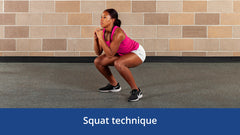Squat Technique
By Aurélien Broussal-Derval
September 24, 2019
One of the oldest maxims of resistance training is that if you aren’t doing squats, then you aren’t actually training.
The squat is an important movement in the world of strength and conditioning!
What is a squat?
This squat consists of flexion followed by extension of the lower limbs with the bar resting on the back of the shoulders. During the exercise, your hip joint passes a point even with or lower than your knee joint. Be sure to get in a stable position before performing the exercise!
What muscles are involved in the squat?
Of the many resistance training exercises, the squat recruits one of the largest assortment of muscles (more than 250!).
Primarily you use the quadriceps (vastus lateralis, vastus intermedius, vastus medialis, and rectus femoris), glutes (gluteus maximus, medius, and minimus), and hamstrings (semimembranosus, semitendinosus, and biceps femoris).
The superficial and deep core muscles (including the erector spinae) and calves (gastrocnemius and soleus) help with stabilization.

Using the rack and loading the bar
Set the supports of the rack to position the bar slightly below shoulder-height. Keep the bar racked and evenly load the weight plates on each end of the bar using a collar to keep the plates in position.
Hand placement on the bar
Position the hands on the bar slightly wider than shoulder-width apart.
Position of the bar on the back
Dip under the bar and position it on top of the trapezius across the posterior deltoids. To keep the bar on the back of the shoulders, use an extended wrist grip (as when accelerating on a motorcycle) with the elbows pointed down.
Get in the beginning position
Extend the hips and knees to lift the bar off the supports then step back but stay close to the supports.
Foot spacing
The stance should be symmetrical and comfortable. Most people place the feet between hip- and shoulder-width apart with the toes slightly angled out.
Position of the head
The neck and head should be natural extensions of the spine; do not tilt the head back or tip it forward. To help with this, look for a visual anchor right in front.
Downward movement
Simultaneously flex the hips and knees to lower the center of gravity. Keep the abdomen flat without exaggerating the lumbar arch. Squat down to the desired level, depending on whether you are planning full or partial squats. Keep the knees aligned with the thighs and feet. Keep the heels flat on the ground.
Upward movement
Extend the hips and knees in synchrony.
Throughout the exercise, pay close attention to the position of the back and the control of pelvic tilt. Be sure to maintain the natural spinal curve; rounding the back can cause injury. Feedback from the spotter can be helpful to improve or maintain proper exercise technique.
For more tips, check out The Modern Art and Science of Mobility and The Modern Art of High Intensity Training.

Latest Posts
- A Guide for Fitness Professionals: Dr. Barbara A. Bushman on Fitness Professional’s Handbook, Eighth Edition
- Single-leg vs. double-leg training for athleticism
- Fountain of youth for athleticism: Lifting, sprinting, or jumping?
- Cause-and-effect connection between physical activity and specific outcomes
- The science of getting stronger without weights
- Periodization: What It Is and How It Relates to Planning and Programming


